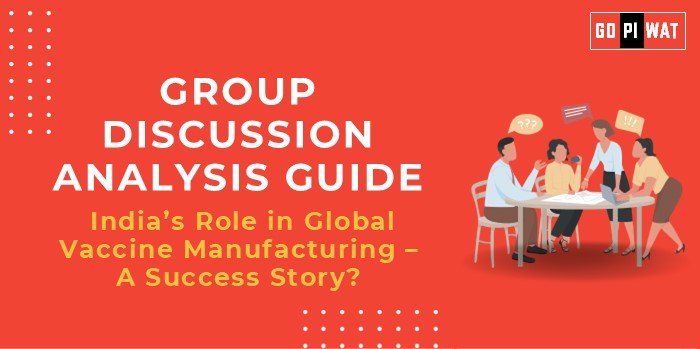📋 Group Discussion (GD) Analysis Guide
📝 Topic: India’s Role in Global Vaccine Manufacturing – A Success Story?
🌐 Introduction
🌏 India, known as the “Pharmacy of the World,” has been pivotal in global vaccine manufacturing, particularly during the COVID-19 pandemic. The country’s ability to supply affordable and accessible vaccines highlights its critical role in addressing global health challenges.
📊 Quick Facts & Key Statistics
- 💉 Vaccine Production: In 2021, India produced over 245 million doses of the Bacillus Calmette–Guérin (BCG) vaccine, underscoring its manufacturing capacity.
- 🌍 Export Reach: By November 29, 2021, India supplied approximately 72.3 million COVID-19 vaccine doses to 94 countries and 2 UN entities.
- 📈 Domestic Coverage: As of January 6, 2023, over 2.2 billion COVID-19 vaccine doses were administered, achieving at least one dose for 97% of eligible beneficiaries and full vaccination for 90%.
- 💰 Economic Impact: India’s vaccination campaign prevented economic losses of $18.3 billion, yielding a net benefit of $15.42 billion after deducting vaccination costs.
🎯 Stakeholders and Their Roles
- 🏛️ Government: Implements policies like Vaccine Maitri and funds initiatives under Atmanirbhar Bharat.
- 💼 Private Companies: Lead in production and distribution (e.g., Serum Institute, Bharat Biotech).
- 🌍 International Organizations: Support global access (e.g., WHO, GAVI, COVAX).
- 👩⚕️ Healthcare Workers: Ensure effective vaccine delivery across diverse geographies.
🏆 Achievements and Challenges
🔑 Achievements
- 📈 High Domestic Vaccination Coverage: 90% of the eligible population fully vaccinated by 2023.
- 🌍 Substantial Export Contributions: Vaccines supplied to 94 countries and two UN entities under Vaccine Maitri.
- 💰 Economic Gains: Efficient vaccine rollout contributed a net economic benefit of $15.42 billion.
⚠️ Challenges
- 📦 Dependence on Imports: Raw materials for vaccine production are heavily sourced externally.
- 📉 Logistical Hurdles: Inadequate cold chain infrastructure in rural areas.
- 🔬 Need for Advanced R&D: To compete with innovations like mRNA vaccines.
🌍 Global Comparisons
- 🇺🇸 United States: Focused on advanced R&D for mRNA vaccines.
- 🇨🇳 China: Diversified vaccine manufacturing capabilities but faced trust issues regarding efficacy.
💡 Effective Discussion Approaches
🌟 Opening Approaches
- 💉 “India’s production of over 245 million BCG doses in 2021 exemplifies its capacity as the ‘Pharmacy of the World.'”
- 🌍 “Supplying vaccines to 94 countries highlights India’s commitment to global health.”
🎯 Counter-Argument Handling
- 📦 Acknowledge reliance on imported materials but highlight policy measures for self-reliance and raw material production.
- 📋 Address logistical challenges with ongoing investments in cold chain infrastructure and tech-enabled distribution systems.
📊 Strategic Analysis of Strengths & Weaknesses
🔍 SWOT Analysis
- 💪 Strengths: High-volume production, affordable costs, and global outreach.
- 📉 Weaknesses: Limited raw material independence and infrastructure gaps.
- 🌟 Opportunities: Collaboration for mRNA vaccine development and expanding global partnerships.
- ⚠️ Threats: Geopolitical tensions and competition from global pharmaceutical giants.
🗣️ Structured Arguments for Discussion
- ✅ Supporting Stance: “India’s ability to vaccinate 97% of its eligible population demonstrates remarkable efficiency and commitment.”
- ❌ Opposing Stance: “Dependence on external raw materials limits India’s full potential as a self-reliant vaccine manufacturer.”
- ⚖️ Balanced Perspective: “India’s achievements are unparalleled, but challenges like infrastructure gaps require attention for sustainable leadership.”
📚 Connecting with B-School Applications
- 🧠 Real-World Applications: Case studies on supply chain optimization in healthcare and the role of public-private partnerships in large-scale operations.
- 📋 Sample Interview Questions:
- 🤔 “What makes India a key player in global vaccine production?”
- 📊 “Discuss the impact of India’s vaccination drive on its economy.”
- 💡 Insights for Students: Opportunities to explore vaccine supply chain models, scalability, and policy frameworks supporting healthcare innovations.


